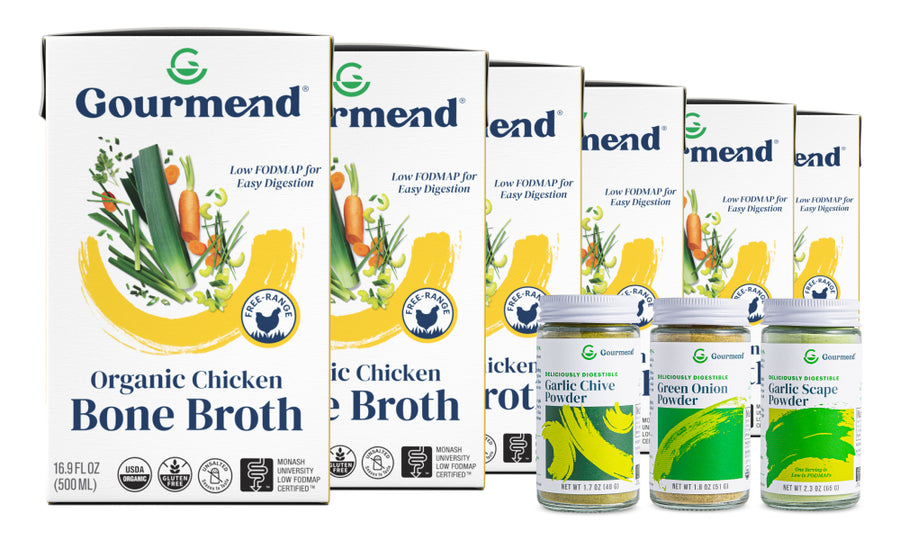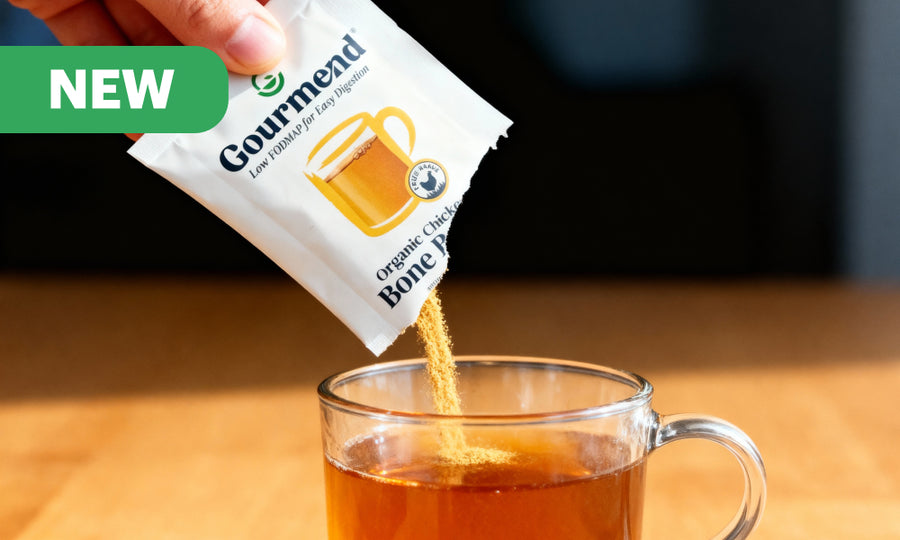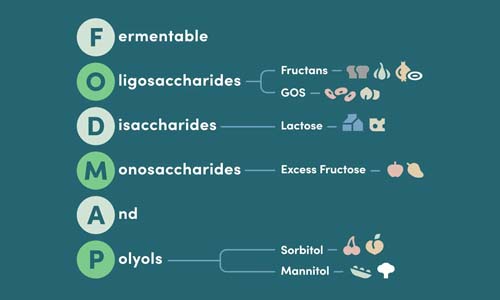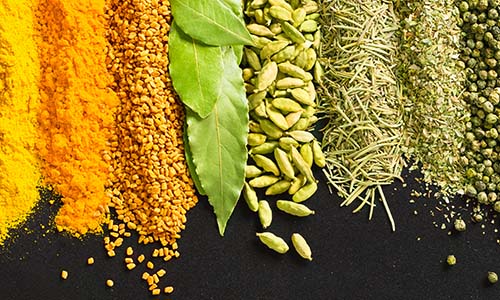Is Zucchini Low FODMAP? Your Essential Guide
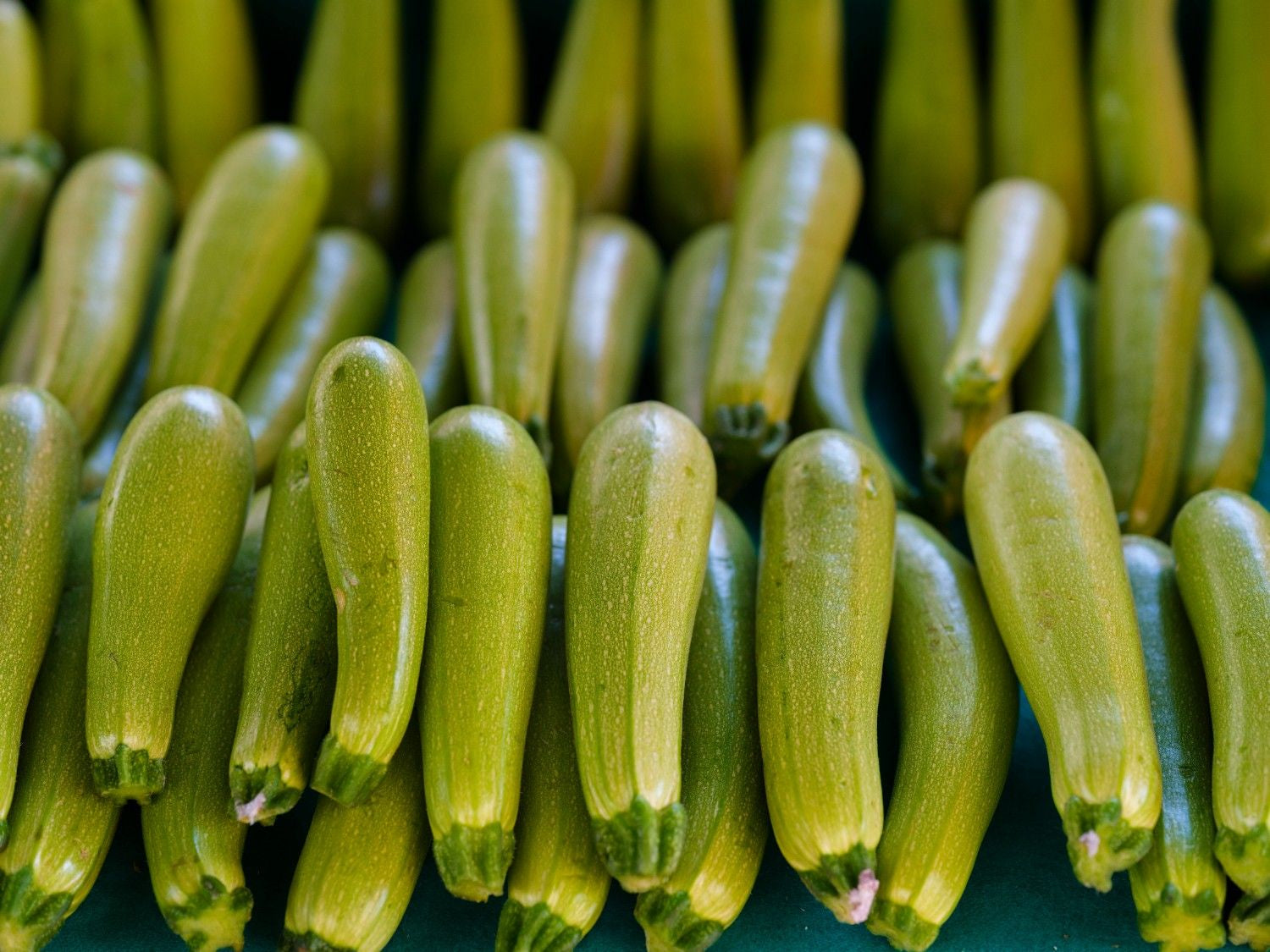
If you're managing IBS symptoms with a low FODMAP diet, you've probably wondered about your favorite summer vegetables. The good news? Zucchini is low FODMAP when eaten in controlled portions – specifically 65g per serving according to Monash University research. For a deeper dive into the science and practical tips, check out our FODMAP blog.
Key Takeaways
- Zucchini is considered low FODMAP when consumed in specific serving sizes.
- Monash University recommends a portion size of 65g, or about ⅓ cup diced, per meal.
- Eating zucchini within the recommended serving helps avoid digestive discomfort.
- Following a low FODMAP diet can help manage IBS symptoms effectively.
Table of Contents
The low FODMAP diet has become a game-changer for the nearly 1 billion people worldwide living with IBS. By limiting certain carbohydrates that can trigger digestive symptoms, this approach helps reduce bloating, gas, and stomach pain that can make mealtimes stressful. For an authoritative overview, see this guide from Johns Hopkins Medicine.
But here's what makes zucchini tricky: like many vegetables, its FODMAP content changes dramatically based on portion size. What starts as a gut-friendly ingredient can quickly become a symptom trigger if you eat too much. We'll walk you through exactly how to enjoy zucchini without the digestive drama, plus share some of our favorite low FODMAP recipes that make the most of this versatile summer vegetable.
Understanding FODMAPs and Portion Control
What Are FODMAPs?
FODMAPs stands for Fermentable Oligo-, Di-, Mono-saccharides and Polyols – essentially, specific types of carbohydrates that can wreak havoc on sensitive digestive systems. These compounds aren't inherently "bad," but for people with IBS, they can ferment in the gut, causing uncomfortable symptoms like bloating, gas, cramping, and changes in bowel movements. For more on how FODMAPs impact IBS, visit AboutIBS.org.
Here's the thing: FODMAPs affect roughly two-thirds of Americans who experience digestive issues. If you've ever felt bloated after eating certain fruits, vegetables, or grains, you might be experiencing a FODMAP reaction.
The most common FODMAPs include fructose (found in some fruits), lactose (dairy), fructans (wheat, onions, garlic), galactans (beans, lentils), and polyols (sugar alcohols, some stone fruits). Understanding these categories helps you make informed choices about what to eat and when.
Why Portion Size Matters for FODMAPs
This is where things get interesting – and where zucchini comes into play. FODMAP content isn't just about the ingredient itself; it's about how much you eat. A food can be perfectly low FODMAP in small amounts but trigger symptoms when you eat larger portions.
Think of it like a threshold effect. Your digestive system can handle a certain amount of FODMAPs before symptoms kick in. Stay under that threshold, and you're golden. Cross it, and you might experience the digestive discomfort you're trying to avoid.
Key Insight: Monash University and FODMAP Friendly are the gold standard for serving size recommendations. These organizations conduct rigorous lab testing to determine exactly how much of each food is considered low FODMAP.
This is why we always emphasize measuring your portions, especially when you're in the elimination phase of the low FODMAP diet. It might seem tedious at first, but it's the difference between enjoying your favorite foods and accidentally triggering symptoms.
Zucchini and FODMAPs: What You Need to Know
Is Zucchini Low FODMAP?
Yes, but only in controlled portions! According to Monash University research, zucchini is low FODMAP at 65g (about ⅓ cup diced). FODMAP Friendly testing shows it's low FODMAP at 75g (about ½ cup). Here's where it gets crucial: consuming more than these amounts increases the FODMAP content significantly.
At 70g, zucchini becomes moderate FODMAP according to Monash testing. Push it to 100g or more, and you're in high FODMAP territory – exactly where you don't want to be if you're managing IBS symptoms.
We've seen this pattern with many of our Gourmend customers who love making zucchini noodles or adding extra vegetables to their meals. The enthusiasm for eating more vegetables is wonderful, but with zucchini, more isn't always better for your digestive comfort.
Why Serving Size Varies
You might wonder why Monash University and FODMAP Friendly have slightly different recommendations. It comes down to lab testing differences, growing conditions, and even zucchini varieties. These factors can affect FODMAP content, which is why the guidelines serve as starting points rather than absolute rules.
Pro Tip: Personal tolerance is key. Some people can handle the upper end of these recommendations, while others need to stay closer to the lower end. Listen to your body and adjust accordingly.
| Portion (g) | FODMAP Rating | Source |
|---|---|---|
| 65g | Low FODMAP | Monash University |
| 70g | Moderate FODMAP | Monash University |
| 75g | Low FODMAP | FODMAP Friendly |
| 100g+ | High FODMAP | Monash University |
How to Enjoy Zucchini on a Low FODMAP Diet
Tips to Stay on Track
Always weigh zucchini before cooking – this is especially important for popular dishes like zoodles or spiralized zucchini. Once you start spiralizing, it's easy to lose track of how much you're actually eating. A kitchen scale becomes your best friend here.
- Stick to one low FODMAP portion per meal to avoid stacking effects
- Use small to medium zucchinis for fresher flavor and easier portion control
- Prep your portions in advance – wash, dice, and store in 65g containers
- When dining out, ask for zucchini as a side dish rather than as a main component
At a Glance: A 65g portion of zucchini is roughly equivalent to ⅓ cup diced, 2-3 thin slices, or about a 4-inch section of medium zucchini.
One strategy that works well for our customers is batch-prepping zucchini portions on Sunday. Wash, dice, and portion out your zucchini for the week in small containers. This way, you're never guessing about portion sizes when you're cooking during busy weeknights. For more meal inspiration, browse our low FODMAP recipes blog.
Low FODMAP Zucchini Recipe Ideas
Low FODMAP Zucchini Walnut Muffins
These muffins are perfect for using up summer zucchini while keeping portions controlled. Each muffin contains just the right amount of zucchini to stay within low FODMAP limits, and the walnuts add healthy fats and protein.
Spring & Summer Roasted Vegetable Lasagna
Layer thin zucchini slices with other low FODMAP vegetables like bell peppers and carrots. Using our Gourmend vegetable broth in the sauce adds rich, savory flavor without any onion or garlic triggers.
Zucchini & Rice Slice
This family-friendly dish works great for meal prep. The rice provides substance while the zucchini adds moisture and nutrients. It's equally delicious warm or cold, making it perfect for lunchboxes.
Low FODMAP Ratatouille
A summer comfort food that celebrates zucchini alongside other gut-friendly vegetables. The key is using the green parts of scallions and leeks instead of onions, plus fresh herbs for brightness.
Grilled Zucchini Slices
Simple, quick, and portion-safe. Brush with garlic-infused oil (not raw garlic!) and sprinkle with fresh herbs. The grilling process concentrates the flavors while keeping the preparation minimal.
When cooking with zucchini on a low FODMAP diet, preparation and measurement become your best allies. The difference between a comfortable meal and digestive discomfort often comes down to those crucial grams we discussed earlier.
Zucchini Stir-Fry with Ginger
Quick, flavorful, and easy to portion control. Fresh ginger adds warmth and digestive benefits, while keeping the zucchini crisp-tender preserves both texture and nutrients. Pair with your favorite protein for a complete meal. If you love creative, globally-inspired meals, try our Indian Spiced Low FODMAP Chicken Tortillas for another delicious option.
Low FODMAP Spaghetti Zoodles
The spiralized zucchini trend doesn't have to be off-limits. Use a kitchen scale to measure exactly 65g of zucchini before spiralizing. Top with a simple olive oil and herb sauce, or try our low FODMAP marinara recipe made with fresh tomatoes instead of garlic and onions.
Remember: These recipes work best when you measure ingredients before cooking. Heat and moisture can change the volume of vegetables, but the FODMAP content remains the same based on raw weight.
Other Great Low FODMAP Summer Vegetables
The Best Low FODMAP Options
Summer brings an abundance of gut-friendly vegetables that can diversify your meals while keeping your digestive system happy. Here are our top picks for vegetables that pair beautifully with zucchini in seasonal dishes:
- Carrots: No detected FODMAPs – enjoy freely in large amounts
- Cucumbers: Low FODMAP at 75g per serving, perfect for salads
- Tomatoes: Low FODMAP at 100g per serving, ideal for summer sauces
- Red bell peppers: Zero FODMAPs detected – add color and crunch without worry
- Green beans: Low FODMAP at 75g per serving, great for stir-fries
- Eggplant: Low FODMAP in small servings, excellent for Mediterranean dishes
Pro Tip: Red bell peppers are particularly valuable because they contain zero detectable FODMAPs. This means you can use them more liberally to add bulk and flavor to dishes where you're already using your zucchini portion.
These vegetables work wonderfully in combination with zucchini. For example, a summer vegetable medley using 65g zucchini, 75g green beans, and unlimited red bell peppers creates a colorful, satisfying side dish that's completely low FODMAP.
Portion-Controlled Vegetables to Watch
Some summer favorites require the same careful attention to portion size as zucchini. Understanding these limits helps you create balanced, symptom-free meals:
- Canned tomatoes:
- Low FODMAP at 100g per serving – perfect for making quick sauces with our Gourmend vegetable broth
- Bok choy:
- Low FODMAP at 75g, but becomes higher FODMAP above 112g – great for Asian-inspired dishes
- Strawberries:
- Low FODMAP at 5 medium berries – a sweet finish to summer meals
- Snow peas:
- Low FODMAP at 75g – adds crunch and sweetness to stir-fries
Consider This: When planning meals, think about FODMAP "stacking" – eating multiple moderate-FODMAP foods in one meal can push your total FODMAP load too high, even if each individual food is within safe limits.
Smart Tips for Enjoying Low FODMAP Veggies All Summer
Rotate Vegetables for Variety and Balance
Summer's bounty means you don't have to rely on the same vegetables every day. Rotating your vegetable choices keeps meals interesting while ensuring you get a wide range of nutrients. Monday might feature zucchini in your morning muffins, while Tuesday showcases bell peppers in a colorful stir-fry. For more on building a sustainable approach, visit our Learn blog.
Expert Insight: Nutritional variety is just as important as symptom management. Different colored vegetables provide different antioxidants and nutrients, so aim for a rainbow throughout your week.
This rotation strategy also prevents you from getting bored with the low FODMAP diet. Many of our Gourmend customers tell us that variety was key to sticking with their dietary changes long-term.
Flavor Without the FODMAP Triggers
One of the biggest challenges people face on a low FODMAP diet is missing the deep, savory flavors that garlic and onions provide. Here's where smart substitutions make all the difference:
- Garlic-infused oils: Use store-bought versions or make your own by heating oil with whole garlic cloves, then removing them
- Fresh herbs: Basil, oregano, thyme, and rosemary add complexity without FODMAPs
- Scallion greens: The green parts only – they provide onion-like flavor safely
- Ginger and turmeric: Add warmth and anti-inflammatory benefits
- Citrus zest: Lemon and lime zest brighten vegetables without adding FODMAPs
At a Glance: Our Gourmend broths are made with chives and the green parts of scallions and leeks instead of onions, plus nori seaweed and oyster mushrooms for natural umami. This creates rich, complex flavors without any FODMAP triggers.
Cooking Methods That Maximize Taste
Grilling, roasting, and steaming are your best friends when cooking low FODMAP vegetables. These methods concentrate flavors while maintaining the vegetables' nutritional integrity.
Grilling caramelizes the natural sugars in vegetables like zucchini and bell peppers, creating deeper, more complex flavors without adding any FODMAPs. Roasting at high heat (425°F) achieves similar results with less hands-on time.
Steaming preserves the most nutrients and works particularly well for more delicate vegetables. When you steam zucchini, it retains its bright color and crisp-tender texture – perfect for adding to grain bowls or serving as a simple side dish.
For busy weeknights, try batch-cooking your vegetables on Sunday. Roast a large pan of mixed low FODMAP vegetables, then reheat portions throughout the week. This strategy saves time while ensuring you always have gut-friendly options ready.
Sample Low FODMAP Summer Meal Plan
A Day of Zucchini-Focused Eating
Here's how to incorporate zucchini into a full day of low FODMAP eating while maintaining proper portion control and nutritional balance:
Breakfast: Zucchini & Rice Slice
Start your day with a protein-rich slice that includes your 65g portion of zucchini. Pair with 5 fresh strawberries for natural sweetness and vitamin C.
Lunch: Spring & Summer Roasted Vegetable Lasagna
Layer thin zucchini slices with red bell peppers and carrots. Use our Gourmend vegetable broth in the sauce for rich flavor without onion or garlic. Since you used zucchini at breakfast, substitute with extra bell peppers or eggplant for this meal.
Snack: Cucumber Slices with Herb Oil
Fresh cucumber (75g) drizzled with garlic-infused olive oil and fresh dill. This keeps you satisfied without using your zucchini portion.
Dinner: Grilled Chicken Ratatouille
If you haven't had zucchini yet today, this is perfect. Combine your 65g zucchini portion with tomatoes, bell peppers, and eggplant. Serve over quinoa with grilled chicken for complete protein.
Important Note: This meal plan shows zucchini in multiple meals for illustration, but in practice, you'd choose one zucchini-containing meal per day to stay within FODMAP limits.
Weekly Rotation Strategy
To prevent FODMAP stacking and maintain variety, consider this weekly approach:
| Day | Featured Vegetable | Serving Size | Meal Suggestion |
|---|---|---|---|
| Monday | Zucchini | 65g | Breakfast muffins |
| Tuesday | Bell Peppers | Unlimited | Stuffed peppers |
| Wednesday | Green Beans | 75g | Stir-fry dinner |
| Thursday | Zucchini | 65g | Zoodle lunch |
| Friday | Carrots | Unlimited | Roasted vegetable medley |
This rotation ensures you're getting diverse nutrients while respecting FODMAP limits. It also prevents the monotony that can make any dietary change feel restrictive.
Meal Prep Tip: Prepare your vegetable portions for the week on Sunday. Wash, chop, and store each day's vegetables in separate containers with the exact measurements. This removes guesswork during busy weekdays.
Storage Tip: Pre-measured vegetables stay fresh longer when stored properly. Keep zucchini in the refrigerator crisper drawer, and don't wash until you're ready to use them.
Your Path to Confident Low FODMAP Eating
Understanding that zucchini is low FODMAP at 65g per serving opens up a world of culinary possibilities for people managing IBS and digestive sensitivities. The key isn't avoiding zucchini – it's embracing it within the right portion parameters.
Remember These Essentials: Portion control is everything with zucchini. That 65g limit isn't arbitrary – it's based on rigorous testing by Monash University researchers who understand exactly how FODMAPs affect digestion.
What makes zucchini particularly valuable for low FODMAP cooking is its versatility. Whether you're spiralizing it into noodles, baking it into muffins, or grilling it as a side dish, zucchini adapts to virtually any cooking method while maintaining its gentle impact on digestion.
Building Sustainable Low FODMAP Habits
The difference between short-term dietary changes and lasting lifestyle improvements often comes down to practical systems. Successful low FODMAP eating requires tools that make portion control automatic rather than stressful.
From Our Kitchen: We've found that our Gourmend customers who invest in a good kitchen scale and use it consistently report better symptom management and more confidence in their cooking.
This systematic approach extends beyond zucchini to all your low FODMAP cooking. When you develop reliable habits around measuring, preparing, and rotating vegetables, you create a foundation for long-term digestive health without sacrificing flavor or satisfaction.
Expanding Your Low FODMAP Toolkit
Zucchini represents just one piece of a comprehensive low FODMAP strategy. The principles you've learned here – understanding portion limits, measuring accurately, and combining foods thoughtfully – apply to countless other ingredients.
Next Steps: Use our Low FODMAP Recipe Conversion Tool to transform your favorite summer recipes. This free resource helps you substitute high-FODMAP ingredients with gut-friendly alternatives while maintaining the flavors you love.
The beauty of mastering low FODMAP cooking lies in its cumulative effect. Each successful meal builds your confidence, expands your repertoire, and proves that digestive health doesn't require culinary compromise.
Yes, you can absolutely enjoy zucchini on a low FODMAP diet. Stick to 65g per meal, measure before cooking, and explore the many delicious ways to prepare this versatile summer vegetable. Your digestive system – and your taste buds – will thank you.
Remember, the low FODMAP diet isn't about perfection; it's about finding your personal balance between symptom management and food enjoyment. Zucchini, with its mild flavor and impressive nutritional profile, offers an excellent starting point for anyone looking to expand their low FODMAP vegetable repertoire while maintaining digestive comfort.
Final Thought: Every small step toward better digestive health matters. Whether you're just starting your low FODMAP journey or you're a seasoned pro looking to add more variety, zucchini provides a reliable, delicious foundation for countless gut-friendly meals.
Check out our Low Fodmap Organic Vegetable Broth
Frequently Asked Questions
Is zucchini ok with IBS?
Yes, zucchini is generally well tolerated by people with IBS when eaten in moderate amounts. It’s low FODMAP in appropriate servings and offers gentle fiber that supports digestion without triggering common IBS symptoms like bloating or cramping.
How much zucchini low FODMAP?
The low FODMAP serving size for zucchini is about ½ cup or 65 grams per serving. Sticking to this portion helps keep fructan levels low, which makes zucchini a gut-friendly choice that adds moisture and mild flavor to your meals.
What vegetables are low in FODMAP?
Low FODMAP vegetables include carrots, spinach, cucumbers, bell peppers, green beans, and the green parts of scallions and leeks. These vegetables provide essential nutrients and flavor without the fermentable carbs that can cause digestive discomfort.
Is zucchini OK for Sibo?
Zucchini is generally a safe vegetable for people managing SIBO because it’s low in fermentable sugars that feed unwanted bacteria. Its mild fiber and water content help support easier digestion, making it a good option in a SIBO-friendly diet.
Does cooked zucchini cause gas?
Cooked zucchini is less likely to cause gas compared to raw because cooking breaks down some of the fiber and complex carbs. When eaten in proper low FODMAP amounts, it’s gentle on the gut and shouldn’t contribute to gas or bloating.
What vegetables should I avoid with irritable bowel syndrome?
People with IBS often do best avoiding high FODMAP vegetables like onions, garlic, cauliflower, mushrooms (except oyster mushrooms), asparagus, and artichokes. These contain fermentable carbs that can trigger symptoms like gas, bloating, and cramping.
